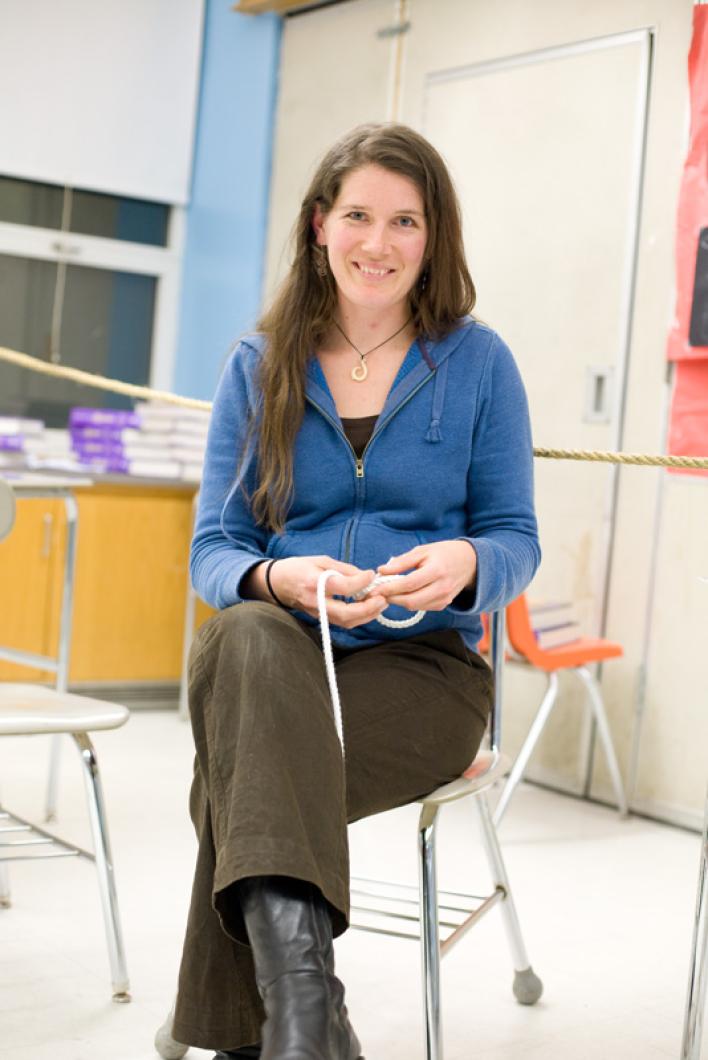Lily Morris holds three feet of line, with one end in each hand and the rest dangling between her arms.
“This is the bitter end,” she says, indicating the portion in her right hand, “the end that you work with when you’re tying a knot. And this is the standing end, the part that attaches to something else,” she says, wiggling her left hand. “The section in the middle is called the bight.”
Lily deftly forms the bight into a perfectly round loop, passes the bitter end up, through the loop, around the back and then down through the eye of the loop again. She then finishes by tying a stopper knot to prevent the line from slipping. She seems to perform the act without thinking. The seven students circled around Lily attempt to copy her precise motions with the pieces of line in their hands. There is some hesitation.
Lily repeats the motions, slower this time, so the group can watch carefully and try again. “This knot is called a bowline, the most useful and most widely used sailors’ knot,” she says. Following the path of Lily’s fingers is tricky — the hand in motion often obscured by the hand holding still; is she moving the line under or over itself, to the left or right, behind the loop or in front? It’s like trying to follow the ace in a game of Three Card Monty, especially when she moves quickly.
Being able to tie knots is crucial to sailing, Lily explains to the class: “There are so many situations when you are sailing, or even just working around boats, where you need to be able to tie a knot, and tie it quickly or tightly — to the point where people’s lives depend on it. The stakes go up on the larger ships because all of the gear is bigger and heavier and therefore more dangerous if something goes wrong.”
Born and raised on Chappaquiddick, Lily has been sailing since she was a child, on boats small and large. “I’ve been sailing since I was little,” she says. “I learned on daysailers, Sunfish and lasers, mostly on Cape Pogue and in Edgartown Harbor. My family taught me — and I taught myself.”
Lily was home-schooled for much of her childhood, a process that often involved heading out into the community to find people who could teach her about the things she found most interesting. When she was 12, Lily went on the Shenandoah for a week-long camp and then worked that summer as an assistant teacher for the Chappaquiddick Community Center sailing program. Lily sailed for two weeks on the Alabama when she was 14 — and that, she says, “confirmed for me that I wanted to be a sailor, as a job and a lifestyle.”
Lily’s talent and love of sailing led her off Martha’s Vineyard and to places far across the world. She signed on with the Ocean Classroom Foundation, sailing on the schooners Harvey Gamage and Westward, first as a student in a two-month high school program and then working as a deckhand, bosun, third and second mates and shipwright on voyages south to Bermuda and Venezuela and then back north to Boston and Halifax, Nova Scotia.
Lily has sailed on other traditionally rigged ships — Picton Castle in Nova Scotia, Hawaiian Chieftain in California, Virginia and Spirit of Massachusetts. Her last sailing job was on a square tops’l schooner — similar to the Shenandoah — the Pride of Baltimore II, the goodwill ambassador for the state of Maryland, sailing around the Chesapeake Bay and then across the Atlantic to England and along the coast of northern Europe as part of a celebration of tall ships from around the world.
Lily moves around the circle of students, adjusting the movement of a hand, the way someone’s fingers are pinching the rope, the direction of the bitter end. “This end goes around back before going through the loop,” she explains, as she guides the class through a series of increasingly difficult knots — the reef knot, the thief knot, the figure eight — and with her help, the students progress from being able to tie their shoes in the morning to feeling capable of securing a boat to a dock in a pitching sea.
Lily explains each knot step by step. “But you won’t be able to remember these unless you repeat them often enough to get them in your muscle memory,” she says. “That’s how you really learn a knot.” It’s like practicing a Rubik’s Cube over and over until you can do it in the dark, in a crow’s nest with the sea rolling underneath you, knowing that your life might count on it.
“Keep a piece of line in your purse or car and keep practicing,” Lily says as the class comes to an end.
Lily Morris will teach another knot tying seminar at the Martha’s Vineyard Regional High School on Wednesday, April 1 and again on April 8, each workshop from 6:30 to 8:30 p.m. For details, see online acemv.org.






Comments
Comment policy »